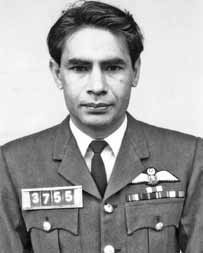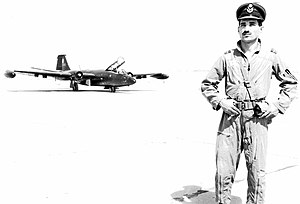
Pakistan Air Force Base Nur Khan is an active Pakistan Air Force airbase located in Chaklala, Rawalpindi, Punjab province, Pakistan. The former Benazir Bhutto International Airport forms part of this airbase. Fazaia Intermediate College, Nur Khan is also located in the base.

Squadron Leader Sarfaraz Ahmed Rafiqui was a fighter pilot in the Pakistan Air Force who is known for his gallant actions in two of the aerial dogfights during Indo-Pakistani War of 1965, and is a recipient of both the Hilal-e-Jurat and the Sitara-e-Jurat military awards from the Government of Pakistan.

Operation Chengiz Khan was the codename assigned to planned Pakistani air and land offensives into India during the Indo-Pakistani war of 1971. The plans for the operation were approved in September 1971.
The Hilal-e-Jurat is the second-highest military award of Pakistan out of a total of four gallantry awards that were created in 1957. In order of rank it comes after the Nishan-e-Haider coming before the Sitara-e-Jurat.
Sitara-e-Jurat is the third highest military award of Pakistan. It was established in 1957 after Pakistan became a republic; however, it was instituted retrospectively back to 1947. It is awarded for gallantry or distinguished service in combat; and can be bestowed upon officers, junior commissioned officers, petty officers, warrant officers, soldiers, sailors, airmen, and equivalents in the Pakistan Army, Navy, Air Force, and various paramilitary forces under federal control, such as the Frontier Corps, the Frontier Constabulary, and the Pakistan Rangers. It may be considered to be roughly equivalent to the Military Cross and the Silver Star.
During the Indo-Pakistani War of 1965, the Indian and Pakistani Air Forces engaged in large-scale aerial combat for the first time. In the air war, which took place in September, both air forces conducted thousands of defensive and offensive sorties over Indian and Pakistani airspace. Both India and Pakistan claimed victory in the air war; Pakistan claimed to have destroyed 104 Indian aircraft and lost 19, and India claimed to have destroyed 73 Pakistani aircraft and lost 35 of its own. The air war ended in a stalemate.
Wing Commander Mervyn Leslie MiddlecoatSJ & Bar was a Pakistani fighter pilot in the Pakistan Air Force (PAF) who was involved in a number of aerial battles during the 1965 and 1971 Indo-Pakistani wars, before being shot down on 12 December 1971. He was one of a number of distinguished Pakistani strike and fighter pilots of the period. Before his death he was stationed at Mauripur, Karachi, Pakistan where he flew the F-104 Starfighter.
Group Captain Cecil ChaudhrySJ, SBt, PP was a Pakistani academic, human rights activist, and a veteran fighter pilot. As a flight lieutenant, he fought in the Indo-Pakistani War of 1965 and as a squadron leader in the Indo-Pakistani War of 1971. During the 1965 war, Chaudhry and three other pilots, under the leadership of Wing Commander Anwar Shamim, attacked the Amritsar Radar Station in a difficult operation. He was awarded the Sitara-e-Jurat for his actions during that mission.
Air Commodore Mukhtar Ahmad Dogar was the Pakistan Air Force bomber pilot and aerial warfare specialist who was the first military person to receive the Pakistani military award Sitara-e-Jurat.
Air Marshal Mohammed Azim Daudpota, commonly known as Azim Daudpota, was the first Sindhi pilot in Pakistan Air Force and the first Sindhi to receive the Sitara-e-Jurrat Award.

Squadron Leader Peter Christy, SJ, was a PAF bomber pilot and weapon systems officer (WSO). A B-57 Canberra navigator, Squadron Leader Christy was officially declared "missing in action" since December 1971, but widely presumed dead by the Pakistan Armed Forces as of 2004.

Syed Manzoor ul Hassan Hashmi was squadron leader in the Pakistan Air Force. He served in the 1965 and 1971 wars. He was a recipient of the Sitara-e-Jurat.

Air Commodore Muhammad Mahmood AlamSJ & Bar SI(M), popularly known as M.M. Alam, was a Pakistani fighter pilot and war hero, officially credited by the Pakistan Air Force with having downed five Indian fighter aircraft in under a minute and establishing a world record during the 1965 Indo-Pak War.

Arshad Sami Khan was a Pakistani diplomat, civil servant and fighter pilot who at peak of his career attained the highest rank of Federal Secretary. He started his career as a Pakistan Air Force fighter pilot and later served three presidents of Pakistan as their aide-de-camp (ADC) and later went on to the Ministry of Foreign Affairs where he served three presidents and four prime ministers as chief of protocol. He was later appointed as a diplomatic ambassador of Pakistan to 14 countries. This was followed by his appointment as the first commissioner general of Pakistan. He was also Federal Secretary of Culture and retired as a top BPS-22 grade bureaucratic officer. He was also the father of singer and music composer Adnan Sami.

Saiful Azam was a Bangladeshi pilot and politician who first served as a fighter pilot for the Pakistan Air Force (PAF) (1960–1971) and later the Bangladesh Air Force (BAF) (1971–1979). According to Pakistani sources, during his career as PAF pilot, he shot down one Indian Air Force (IAF) and three Israel Air Force (IAF) aircraft. For his actions, he received various gallantry awards from Pakistan, Jordan and Iraq. He also took part in 12 ground-attack missions against the Indian forces. After the liberation of Bangladesh, he joined the newly formed Bangladesh Air Force.

Air Force Day is celebrated in Pakistan as a national day on 7 September, after the annual celebration of the Defence Day. Airshows and other programs mark the Pakistan Air Force's (PAF) role in defending the nation in the Indo-Pakistani War of 1965.
Air Commodore Imtiaz BhattiSJ SI(M) SBt in Gujrat, British India, is a cyclist and a former Air Force pilot of Pakistan. He was the Pakistan cycling champion during his student days at Punjab Agriculture College, Lyallpur in late 1940s and early 1950s. He set national cycling records and represented Pakistan in the individual and team road race events at the 1952 Summer Olympics where he was placed 1st among the Asian cyclists and 25th in the world in the 1000 m time trial. Bhatti a veteran of the Indo-Pakistani War of 1965 flew 34 combat missions, the maximum from Pakistan during the war and is credited with confirmed downing of two Indian planes and damaging a third, besides participating in raids that took out the Amritsar radar and various other air defence and ground support missions.

Group Captain Virendera Singh Pathania was an Indian Air Force (IAF) fighter pilot reputed for making the first confirmed aerial dogfight kill of independent India when he shot down a Pakistan Air Force (PAF) Sabre Jet with his Folland Gnat on 4 September, 1965. For this action, he was awarded the Vir Chakra.
No. 8 Squadron, nicknamed the Haiders, is a tactical attack squadron from the No. 32 TA Wing of the Pakistan Air Force's Southern Air Command. It is currently deployed at Masroor Airbase and operates multiple variants of the Dassault Mirage 5 strike fighter.

The Pathankot airstrike was a key aerial operation of the Indo-Pakistani War of 1965. It took place on the evening of September 6, 1965 when the No. 19 Squadron of the Pakistan Air Force (PAF) attacked and destroyed the Indian Air Force (IAF) base at Pathankot. It is the PAF's most successful air raid to date, as well as one of the most successful post-WW2 air raids.













